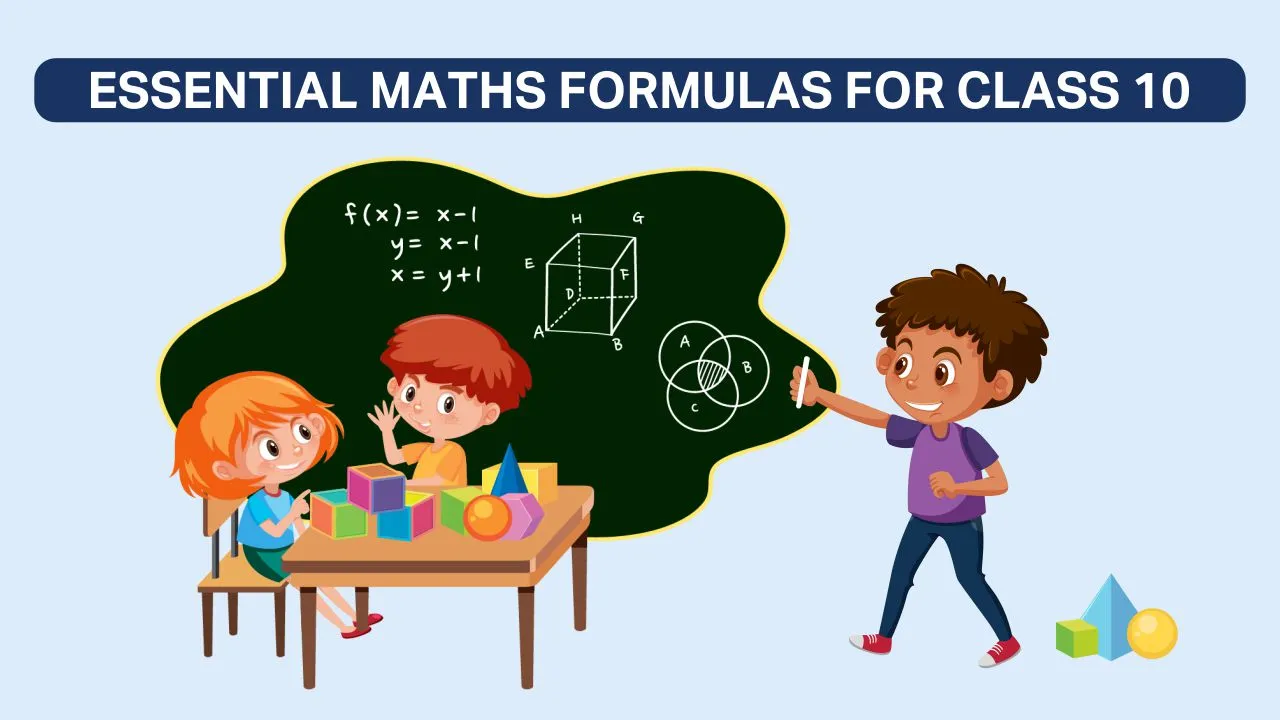Essential Maths Formulas for Class 10
As a Class 10 student, you’re on the brink of a significant academic milestone. Mathematics at this stage plays a pivotal role, not just in your exams but in shaping analytical and problem-solving skills. Mathematics in Class 10 is not just a subject, but a crucial skill that lays the foundation for various concepts and problem-solving techniques used in higher studies and everyday life. Understanding and memorizing mathematical formulas at this level is essential for scoring well in exams and for future academic pursuits. This blog aims to provide a comprehensive guide to all the important Maths Formulas for Class 10 students need to know.
Essential Maths Formulas for Class 10 Chapter Wise
Chapter 1: Real Numbers
Euclid’s Division Lemma: For any two positive integers a and b, there exist unique integers q and r such that a = bq + r, where 0 ≤ r < b. This lemma is a basis for many proofs and problems in this chapter.
Irrational Numbers: An irrational number is a number that cannot be expressed as a ratio of two integers. Their decimal expansions are non-terminating and non-repeating. For example, √2 is an irrational number.
Rational Numbers: A rational number is a number that can be expressed as a ratio of two integers (i.e., in the form p/q, where q is not zero).
Chapter 2: Polynomials
For a quadratic polynomial ax2+ bx+ c, the sum of its zeros α + β is -b
a
and the product αβ of its zeros is C.
a
For a cubic polynomial ax3+bx2+cx + d, if α,β, and γ are its zeros, then
α+β+γ = -b ,
a
αβ+βγ+γα= c
a
αβγ= -d
a
Chapter 3: Pair Of Linear Equations In Two Variables
General Form of Linear Equations:
A linear equation in two variables x and y can be expressed in the form ax+by+c=0, where a, b, and c are real numbers, and a and b are not both zero.
Pair of Linear Equations:
a1x+b1y+c1=0
a2x+b2y+c2=0
Conditions for Consistency:
- A pair of linear equations is consistent if they have a solution.
- The equations are consistent and have a unique solution if a1 ≠ b1
a2 b2
- The equations are consistent and have infinitely many solutions if a1 = b1 = c1
a2 b2 c2
- The equations are inconsistent (have no solution) if a1 = b1 but c1 ≠ b1
a2 b2 c2 b2
Chapter 4: QUADRATIC EQUATIONS
Standard Form of a Quadratic Equation:
A quadratic equation in the variable x is of the form ax2 +bx+c=0, where
a,b, and c are constants, and a≠ 0.
Quadratic Formula:
- The roots of the quadratic equation ax2+bx+c=0 can be found using the formula:
x= -b+(-) √b2-4ac
2a
- The term b2−4ac is known as the discriminant.
Chapter 5: Arithmetic Progressions
Definition of an Arithmetic Progression:
- An arithmetic progression is a sequence of numbers in which the difference between any two consecutive terms is always the same. This difference is called the common difference, denoted as d.
Arithmetic Progressions (AP):
Nth term of an AP: an=a + ( n – 1 ) d
Sum of the first n terms: Sn = n ⦗2a + (n – 1)d ⦘
2
Chapter 6: Triangles
Similar Triangles:
- Two triangles are similar if their corresponding angles are equal and their corresponding sides are in the same ratio.
Basic Proportionality Theorem (or Thales’ Theorem):
- If a line is drawn parallel to one side of a triangle, it divides the other two sides proportionally.
Criteria for Similarity of Triangles:
- AA (Angle-Angle) Similarity Criterion: Two triangles are similar if two pairs of corresponding angles are equal.
- SSS (Side-Side-Side) Similarity Criterion: Two triangles are similar if the corresponding sides are in the same ratio.
- SAS (Side-Angle-Side) Similarity Criterion: Two triangles are similar if one pair of corresponding sides are in the same ratio and the angles included between these sides are equal.
Pythagoras Theorem:
- In a right-angled triangle, the square of the length of the hypotenuse is equal to the sum of the squares of the other two sides. Mathematically, c2=a2+b2 for a right triangle with a hypotenuse c and legs a and b.
Converse of Pythagoras Theorem:
- If the square of one side of a triangle is equal to the sum of the squares of the other two sides, then the triangle is right-angled.
Area of Similar Triangles:
- The ratio of the areas of two similar triangles is equal to the square of the ratio of their corresponding sides.
Mid-point Theorem:
- The line segment joining the mid-points of two sides of a triangle is parallel to the third side and is half of it.
Chapter 7: Coordinate Geometry
Distance Formula:
- The distance between two points(x1,y1) and(x2,y2) in the coordinate plane is given by:
- Distance= √(x2 -x1)2 + (y2-y1) 2
Area of a Triangle:
- The area of a triangle formed by three points (x1,y1),(x2,y2), and(x3,y3) is given by:
Area= 1 ⦗ x1 (y2 – y3) + x2 (y3 – y1) +x 3(y1 – y2) ⦘
2 ⦗ ⦘
Chapter 8: Introduction To Trigonometry
Trigonometric Ratios:
- In a right triangle, if θ is one of the acute angles, then the three main trigonometric ratios are defined as follows:
- Sine (sin θ) = Opposite side / Hypotenuse
- Cosine (cos θ) = Adjacent side / Hypotenuse
- Tangent (tan θ) = Opposite side / Adjacent side
Reciprocal Trigonometric Ratios:
- Cosecant (csc θ) = 1 / sin θ
- Secant (sec θ) = 1 / cos θ
- Cotangent (cot θ) = 1 / tan θ
Pythagorean Trigonometric Identity:
- sin^2 θ + cos^2 θ = 1
Trigonometric Ratios of Complementary Angles:
- sin(90° – θ) = cos θ
- cos(90° – θ) = sin θ
- tan(90° – θ) = 1 / tan θ
Trigonometric Ratios of Special Angles:
- sin 30° = 1/2, cos 30° = √3/2, tan 30° = 1/√3
- sin 45° = cos 45° = 1/√2, tan 45° = 1
- sin 60° = √3/2, cos 60° = 1/2, tan 60° = √3
Trigonometric Ratios of Negative Angles:
- sin(-θ) = -sin θ
- cos(-θ) = cos θ
- tan(-θ) = -tan θ
Chapter 9: Some Applications Of Trigonometry
Important Formulas:
- Distance between two objects (AB) = (BC) / (tan θ), where BC is the vertical height.
- Height of an object (BC) = (AB) × (tan θ), where AB is the horizontal distance.
Chapter 10: Circles
- Circle: A circle is a set of all points in a plane that are equidistant from a fixed point called the center.
- Radius (r): The distance from the center of the circle to any point on the circle.
- Diameter (d): The longest chord of a circle that passes through the center, and it is equal to 2 times the radius (d = 2r).
Circumference of a Circle (C):
- C = 2πr, where π (pi) is approximately 3.14159.
Area of a Circle (A):
A = πr²
Chapter 11: Areas Related To Circles
Circumference of a Circle (C):
C = 2πr, where π (pi) is approximately 3.14159, and r is the radius of the circle.
Area of a Circle (A):
A = πr²
Arc Length (L):
L = (θ/360) * 2πr, where θ is the angle in degrees formed at the center of the circle by the arc.
Area of a Sector (A_sector):
A_sector = (θ/360) * πr², where θ is the angle in degrees formed at the center of the circle by the sector.
Length of an Arc:
The length of an arc (S) can be calculated as: S = (θ/360) * 2πr, where θ is the angle in degrees formed at the center of the circle by the arc.
Length of a Major Arc:
For a major arc (angle > 180 degrees), the length of the arc can be calculated as: S_major = 2πr – S_minor, where S_minor is the length of the corresponding minor arc.
Length of a Minor Arc:
For a minor arc (angle < 180 degrees), the length of the arc can be calculated as S_minor = (θ/360) * 2πr.
Chapter 12: Surface Areas And Volumes
Surface Area of a Cuboid:
Surface Area (S) = 2(lw + lh + wh)
Where:
- l is the length of the cuboid.
- w is the width of the cuboid.
- h is the height of the cuboid.
Lateral Surface Area of a Cuboid:
- Lateral Surface Area (LSA) = 2h(l + w)
- It represents the total area of the four sides of the cuboid, excluding the top and bottom faces.
Total Surface Area of a Cube:
- Total Surface Area (S) = 4a²
- Where “a” is the length of the side of the cube.
Surface Area of a Right Circular Cylinder:
- Curved Surface Area (CSA) = 2πrh
- Total Surface Area (TSA) = 2πrh + 2πr²
Where:
- r is the radius of the base.
- h is the height of the cylinder.
Surface Area of a Right Circular Cone:
- Curved Surface Area (CSA) = πrl
- Total Surface Area (TSA) = πrl + πr²
Where:
- r is the radius of the base.
- l is the slant height of the cone.
Surface Area of a Sphere:
- Surface Area (S) = 4πr²
- Where “r” is the radius of the sphere.
Volume of a Cuboid:
- Volume (V) = lwh
Where:
- l is the length of the cuboid.
- w is the width of the cuboid.
- h is the height of the cuboid.
Volume of a Cube:
- Volume (V) = a³
- Where “a” is the length of the side of the cube.
Volume of a Right Circular Cylinder:
- Volume (V) = πr²h
Where:
- r is the radius of the base.
- h is the height of the cylinder.
Volume of a Right Circular Cone:
- Volume (V) = (1/3)πr²h
Where:
- r is the radius of the base.
- h is the height of the cone.
Volume of a Sphere:
- Volume (V) = (4/3)πr³
- Where “r” is the radius of the sphere.
Frustum of a Cone:
- The frustum of a cone is the portion that remains after cutting off the top portion of a cone with a smaller cone.
Volume of a Frustum of a Cone:
- Volume (V) = (1/3)πh(h₁² + h₂² + h₁h₂)
Where:
- h is the height of the frustum.
- h₁ and h₂ are the heights of the smaller and larger cones, respectively.
Chapter 13: Statistics
Mean (Average):
Mean (μ) = (Sum of all observations) / (Total number of observations)
Median:
Median is the middle value of a data set when the data is arranged in ascending or descending order. If there is an even number of data points, the median is the average of the two middle values.
Mode:
Mode is the value that appears most frequently in a data set.
Range:
Range = (Maximum value) – (Minimum value)
Quartiles:
Quartiles divide a data set into four equal parts. The three quartiles are Q1 (25th percentile), Q2 (50th percentile or median), and Q3 (75th percentile).
Interquartile Range (IQR):
IQR = Q3 – Q1
Variance:
Variance (σ²) = [(Σ(xi – μ)²) / N], where μ is the mean, xi is each individual data point, and N is the total number of data points.
Standard Deviation:
Standard Deviation (σ) = √σ²
Chapter 14: Probability
Probability of an Event (P(E)):
Probability is a measure of the likelihood of an event occurring.
P(E) is a number between 0 (impossible) and 1 (certain).
Probability of Complementary Events:
P(not E) = 1 – P(E)
The probability of an event not occurring is equal to 1 minus the probability of the event occurring.
Probability of the Union of Two Events (P(A ∪ B)):
P(A ∪ B) = P(A) + P(B) – P(A ∩ B)
The probability of either event A or event B occurring (or both) is calculated as the sum of their individual probabilities minus the probability of their intersection.





